Birds make people think twice by having a variety of feather shapes, heads, colors, and other features.
However, Birds with long beaks made me think not only twice, but also led me to do research on the birds with long beaks across the world and write this amazing article for you.
In this article, we are exploring the list of birds with long beaks in the world with amazing pictures of them.
Table of Contents
Birds with Long Beaks
1.Dalmatian Pelican

- Scientific name: Pelecanus crispus
- Length: 1.8 m
- Wingspan: 3.5 m
- Weight: 9.5 Kg
The Dalmatian pelican is one of the largest birds of the pelican family, that is also the world’s largest freshwater bird belonging to the Pelecanidae family, and are the biggest flying bird on the planet. They live in lakes, rivers, deltas, wetlands and estuaries.
It feeds on mainly fish, amphibians, catfish, eels, small reptiles, and aquatic crustaceans, thus they are carnivorous in their diet. These are monogamous birds that will find a mate and stay with the same mate for a lifetime while raising chicks, migrating, and even living together.
2.Black Heron

- Scientific name: Egretta ardesiaca
- Length: 85 cm
- Wingspan: 150
- Weight: 400 gm
The black heron or the black egret, or African heron are found in Africa, Sudan to South Africa, primarily on the eastern continent and in Madagascar, Greece, and Italy. It lives in shallow waters, freshwater lakes, and ponds. and is known to feed on fish, aquatic insects, frogs, clams, mussels, rodents, squid, crustaceans, carrion, and small snakes.
The Black heron illustrates unique behaviors by opening its wings in the sunlight to establish shadow where the fish are normally drawn to these shadows when seeking food, especially the small fishes, so they end up in the mouths of these black herons.
3.White Stork

- Scientific name: Ciconia ciconia
- Length: 1 m
- Wingspan: 2 m
- Weight: 3-4 Kg
The white stork is a type of stork in the Ciconiidae family which is a large bird among many storks, that have white plumage with black wings and also have long red beaks. Whose habitats include wetlands, flooded river plains, and water meadows.
Its food includes small mammals such as voles, shrews and moles, insects such as beetles, grasshoppers, and crickets, reptiles such as snakes and lizards, amphibians such as frogs and newts, fish, molluscs and earthworms.
4.Wood Stork

- Scientific name: Mycteria americana
- Length: 120 cm
- Wingspan: 165 cm
- Weight: 2.5 Kg
The wood stork is a large bird that is wading in the family Ciconiidae and is found in subtropical and tropical areas of the Americas and the Caribbean. These birds breed along the coast from South Carolina to Texas, Florida and Georgia, California, Mexico, and Massachusetts.
They live in swamps, sloughs, mangroves, wetlands such as freshwater, and estuarine marshes. Here in these habitats, they feed on fish, aquatic invertebrates, seeds, amphibians, nestlings, and reptiles. They can fly about 50 miles when it comes to seeking food and can reach an altitude of 6000 feet.
5.Rhinoceros Hornbill

- Scientific name: Buceros rhinoceros
- Length: 90 cm
- Wingspan: 150 cm
- Weight: 2-3 Kg
The rhinoceros hornbill is a large bird that has long and big beaks that belong to the Bucerotidae family, which are usually found in Borneo, Sumatra, Java, the Malay Peninsula, Singapore, and southern Thailand. Their food includes fruit, figs, insects, small reptiles, rodents, and smaller birds.
6.Shoebill
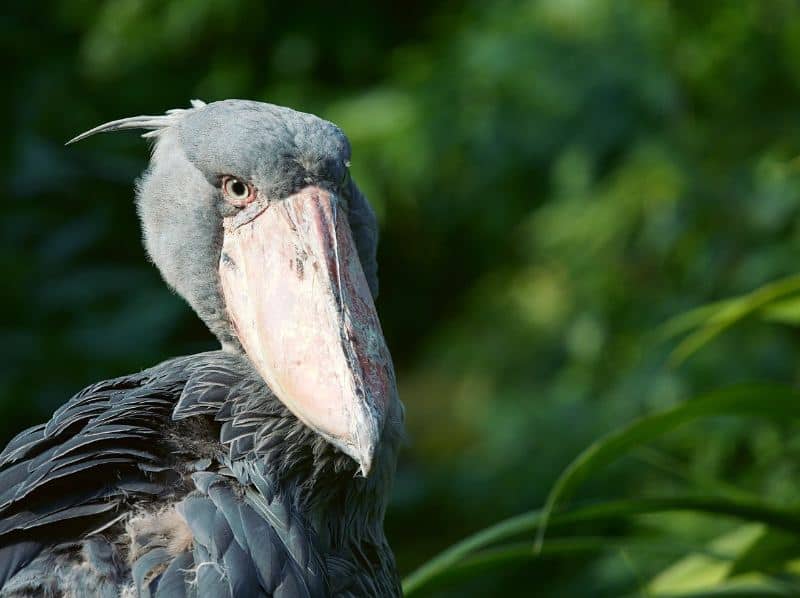
- Scientific name: Balaeniceps rex
- Length: 1.5m
- Wingspan: 2.3 m
- Weight: 5.6 Kg
The shoebill or whale head, or whale-headed stork, or shoe-billed stork, is a large bird and is named so because of a shoe-shaped bill and it belongs to the Balaenicipitidae family. It lives in wetlands and swamp, and feeds on fish like lungfish, eels, catfish, lizards, and snakes.
While they are usually found alone or as alone as they prefer to live, hunt, and eat alone, except during mating times.
7.Great Hornbill
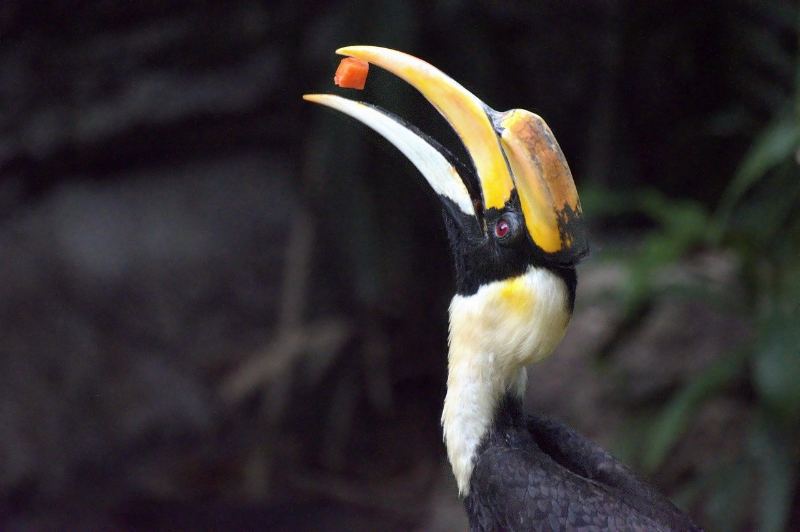
- Scientific name: Buceros bicornis
- Length: 120 cm
- Wingspan: 150 cm
- Weight: 2.8 Kg
The great hornbill or concave-casqued hornbill, great Indian hornbill or great pied hornbill, is a large bird belonging to the hornbill family that is found in the Indian subcontinent and Southeast Asia. These feed on mainly fruit such as figs, small mammals, birds, eggs, amphibians, reptiles and insects. When they fly or beat their wings that could be heard at large distances that can be 1 km away. While they could also eat as many as 150 figs in a meal.
8.Reddish Egret

- Scientific name: Egretta rufescens
- Length: 80 cm
- Wingspan: 125 cm
- Weight: 600 gm
The reddish egret is a type of heron that is native to Central America, the Bahamas, the Caribbean, the Coast of the United States, and Mexico.
They prefer to live in coastal areas and estuaries. Here, In these habitats they feed on small fish, minnows, snails, mullet, frogs, tadpoles, crustaceans, and aquatic insects.
They are easy to spot as anyone would quickly recognize their behaviors as they display behaviors such as running, flying, hopping, wing flicking, and foot-steering while foraging.
9.Long-Billed Curlew

- Scientific name: Numenius americanus
- Length: 65 cm
- Wingspan: 90 cm
- Weight: 600 gm
The long-billed curlew is a large bird with long and sleek beak that is found in North American and it belongs to the Scolopacidae family. Its other names are sickle bird and the candlestick bird.
They usually breed in central and western North America, during winter migrate to the southside and coast side. Its habitats include agricultural fields, wetlands, tidal estuaries, mudflats, flooded fields and beaches.
These feed on insects, marine crustaceans, earthworms, shrimp, crabs, grasshoppers, beetles, caterpillars, spiders, and eggs.
10.American White Pelican
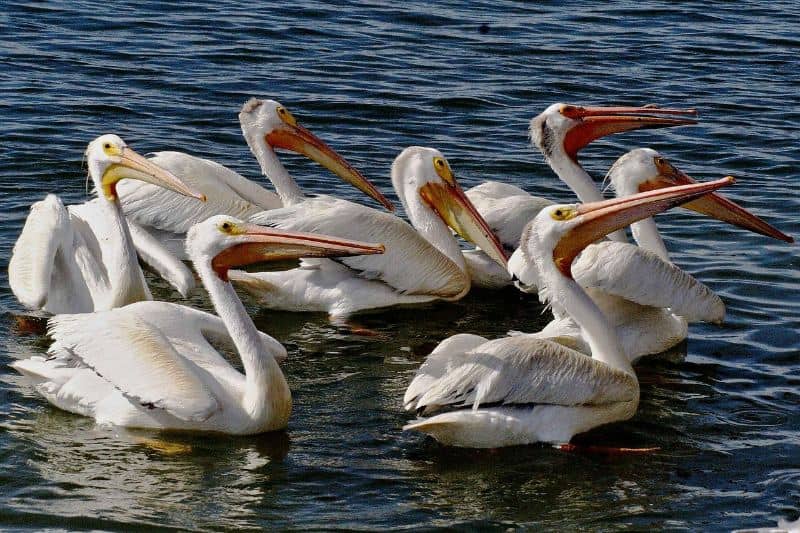
- Scientific name: Pelecanus erythrorhynchos
- Length: 1.6 m
- Wingspan: 3 m
- Weight: 5-6 Kg
The American white pelican is a large bird that is known for aquatic soaring and is found in North America, Central America, South America, and in winter along warm southern coasts. The American white pelican forage at shallow marshes, rivers, and lake edges.
They eat fish, to find food, especially fish, they dip their bills into the water and scoop until they find prey. These eat the fishes that have less economic value.
In a nest, only one dominant will live and mature out of many chicks as the dominant chick kills the other, usually the one or two chicks thus the babies or chicks of American white pelicans show siblicide as it is present in the life of eagles.
11.American Woodcock

- Scientific name: Scolopax minor
- Length: 30 cm
- Wingspan: 50 cm
- Weight: 200 gm
The American woodcock is a small shorebird that has relatively long and slender beaks that are found in North America. They prefer habitats such as slow-flowing rivers and streams, lakes and ponds, and wetlands.
They feed on earthworms and other invertebrates such as snails, millipedes, spiders, flies, beetles, and ants. The other names for American woodcock are timberdoodle, the bog sucker, the hokum poke, or the Labrador twister.
12.Roseate Spoonbill
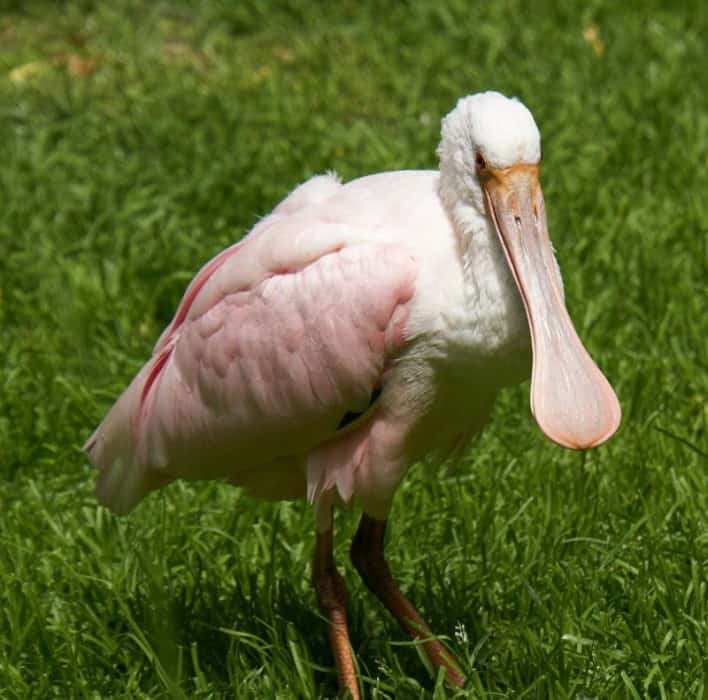
- Scientific name: (Platalea ajaja)
- Length: 85 cm
- Wingspan: 135 cm
- Weight: 1 Kg
The roseate spoonbill is a type of wading bird that is also a large wading bird that belongs to the family Threskiornithidae. They live in marshy areas and mangroves.It feeds on small fish, shrimp, mollusks, snails, and insects.
In Roseate Spoonbills, the pink color is due to their special diet on the crustacean.The bills are not the same as in chicks, but the bills often tend to form as a spoon hape with the development of the chicks.
13.Keel-Billed Toucan
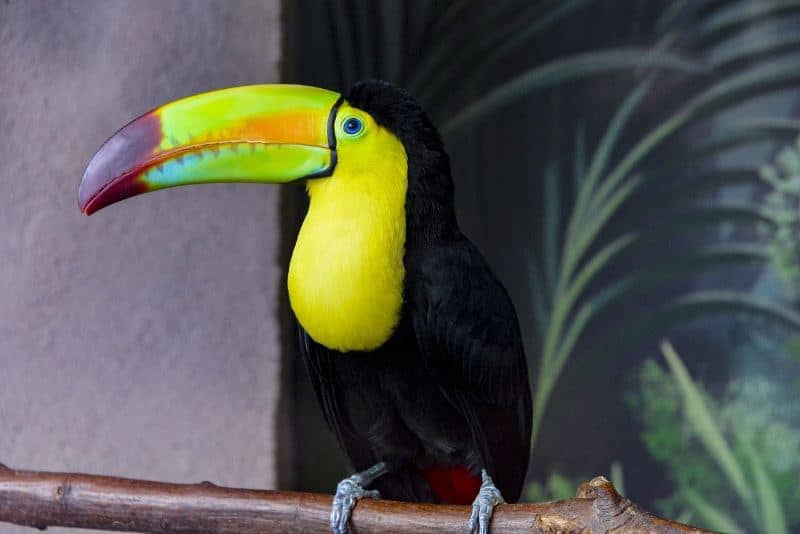
- Scientific name: Ramphastos sulfuratus
- Length: 50 cm
- Wingspan: 150 cm
- Weight: 400 gm
The keel-billed toucan, or the sulfur-breasted toucan or rainbow-billed toucan, is a bird with colorful and long beaks that belongs to the toucan family.
These are found in southern Mexico to Colombia. It is a national bird of Belize. It feeds on mostly fruit, lizards, other bird eggs and nestlings. It is a crepuscular, that is most active during dawn and dusk.
14.Sandhill Crane

- Scientific name: Grus canadensis
- Length: 90 cm
- Wingspan: 100 cm
- Weight: 3-4 Kg
The sandhill crane is a large crane that is found in North America and the regions of Siberia. Its habitat includes marshes, bogs, wet meadows, moist habitats, wetland, croplands, pastures, and grasslands.
They feed on berries, mammals, insects, snails, reptiles, amphibians, and small crustaceans. Cranes use thermals to fly efficiently so they are opportunistic fliers.
They have bills and feet that are like tools when they use the bill to dig the frozen mud, while the feet are also useful in grabbing in slippery places and have sharp claws to dig the dirt while seeking prey and fighting the intruders.
15.Great Spotted Kiwi

- Scientific name: Apteryx haastii
- Length: 45 cm
- Wingspan: 50 cm
- Weight: 3 Kg
The great spotted kiwi is a large flightless bird with a long beak, that is native to South Island of New Zealand.
Their habitat forested mountains, tussock grasslands, beech forests, hardwood forests and scrub. These birds feed on small invertebrates, earthworms, larvae of beetles and cicadas, centipedes, spiders, beetles, snails and freshwater crayfish. The other names of the great spotted kiwi are great grey kiwi or roroa.
16.Straw-Necked Ibis
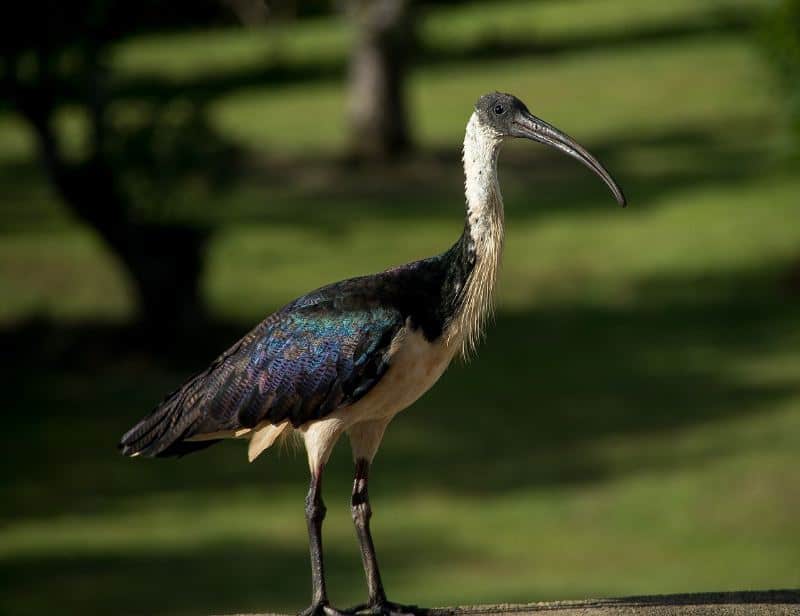
- Scientific name: Threskiornis spinicollis
- Length: 75 cm
- Wingspan: 120 cm
- Weight: 1.5 Kg
The straw-necked ibis is a bird that belongs to the Threskiornithidae family and is found in Australia, New Guinea, and Indonesia.
Their habitat includes shallow freshwater wetlands, cultivated pastures, edges of swamps, lagoons, wet grasslands, and dry grasslands. In male birds, the bills are longer than in females. The appearance of dark wings, multicolored sheen, dark feathers on the back and collar distinguishes the straw-necked ibis while the neck feathers are white along with the ventral parts of the body.
They have down the curved bill and red and black-colored feet. These are known to feed on crustaceans, locusts, grasshoppers, grubs, and yabbies.Straw-necked ibis is named so because of the presence of distinctive straw-like feathers on their necks.
17.Black Skimmer

- Scientific name: Rynchops niger
- Length: 50 cm
- Wingspan: 125 cm
- Weight: 320-440 gm
The black skimmer is a long beaked bird, also a seabird that belongs to the Laridae family that are found in North and South America.
They inhabit estuaries and beaches. Here, they feed on fish, crustaceans, shrimp and blue crab.
18.Pacific Reef Heron
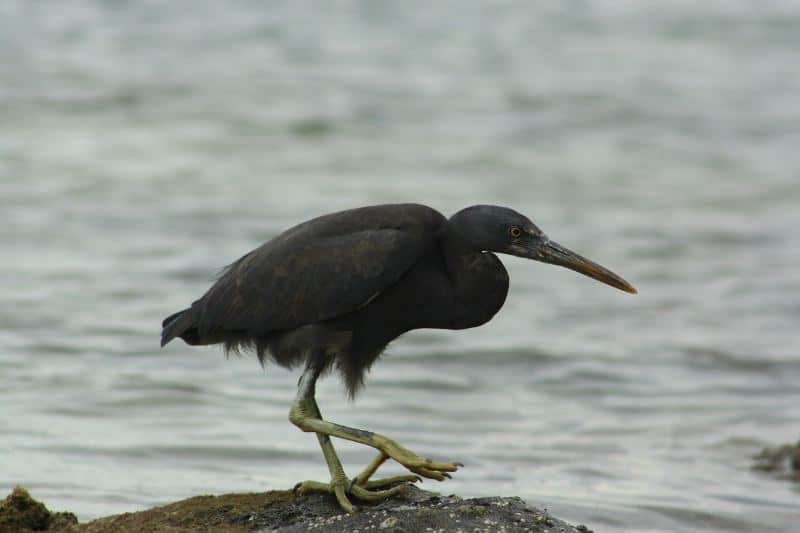
- Scientific name: Egretta sacra
- Length: 66 cm
- Wingspan: 100 cm
- Weight: 700 gm
The Pacific reef heron, or the eastern reef heron or eastern reef egret, is a type of heron distributed in southern Asia. These live in coastal, rocky shores, coral reefs, islands, freshwater marshes, rice fields, estuaries, mangroves, mudflats, and sandy beaches.
They feed on fish, crustaceans, molluscs, invertebrates, crabs, fish such as mudskippers, gobies, blennies, insects, lizards, and chicks.
19.Collared Aracari

- Scientific name: Pteroglossus torquatus
- Length: 41 cm
- Wingspan: 50 cm
- Weight: 210 gm
The collared aracari a toucan, that are found and breeds in southern Mexico to Panama, Ecuador, Colombia, and Venezuela. whose habitats include a variety of wooded places such as wet lowland, forest, forest patches, and coffee plantations, cacao plantations.
They feed on insects, eggs, fresh fruits, dry fruits thus they are omnivorous in diet.
20.Black Stork
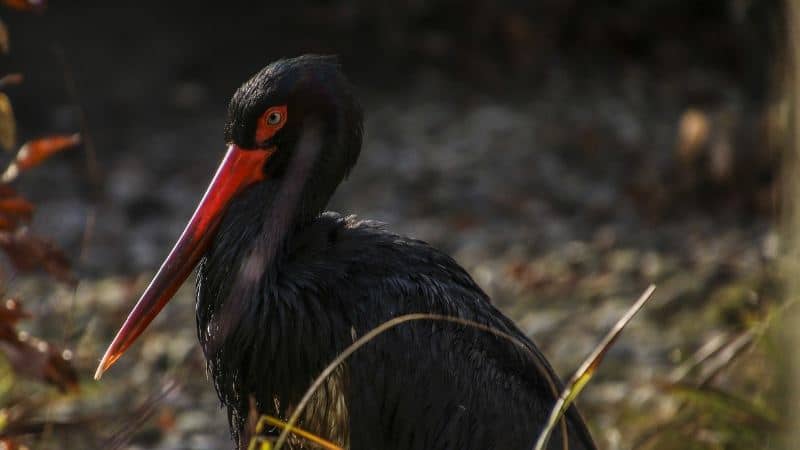
- Scientific name: Ciconia nigra
- Length: 110 cm
- wingspan: 155 cm
- Weight: 3 Kg
The black stork is a large bird that belongs to the stork family Ciconiidae and is found in Malawi, Namibia to South Africa. Winters in Africa, Indochina, China, Taiwan, and South Korea. These lives in ponds, estuaries, lakes and rivers.
The diet of these birds includes amphibians, small reptiles, crabs, mammals, snails, mollusks, earthworms, shrimps, aquatic insects like water beetles, and their larvae.
The black stork can produce raptor-like whistles, grunts, and growls when disturbed, and show Bill-clapping when they are excited and also in display mode.
Read More : Symbolism Of Birds !
21.Southern Yellow-Billed Hornbill

- Scientific name: Tockus leucomelas
- Length: 60 cm
- Weight: 130 – 240 Gm
The southern yellow-billed hornbill is a type of hornbill that are found in southern Africa. Its habitat includes scattered trees, thorn bushes, open woodlands, waterside vegetation, other areas with tall and dense vegetation.
These birds feed mainly on seeds, small insects, spiders, scorpions and occasionally fruit, thus they are omnivorous in their diet.
22.Grey Heron
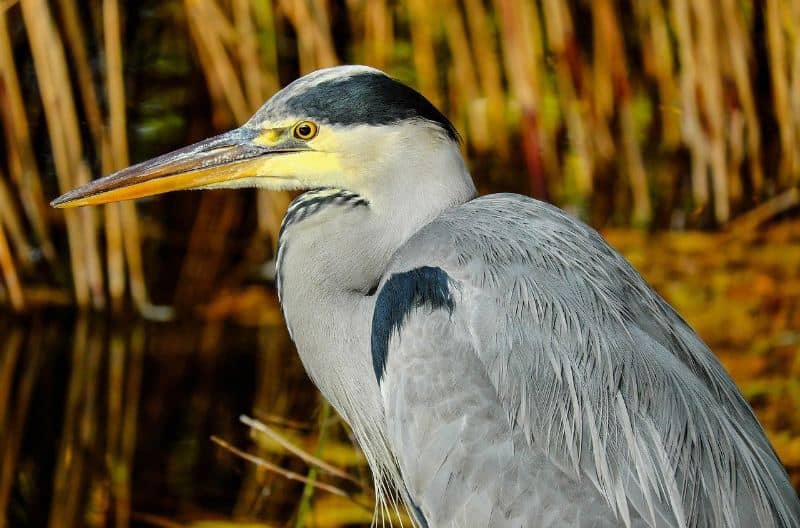
- Scientific name: Ardea cinerea
- Length: 1 m
- Wingspan: 2 m
- Weight: 2.1 Kg
The grey heron is a long-legged and long-necked wading bird that belongs to the Ardeidae. Whose habitats are ponds, lakes, rivers, and estuaries and are found as far east as Japan, Europe, and Asia and also in parts of Africa.
These feed on fish, amphibians, crustaceans, aquatic invertebrates, mollusks, snakes, small birds, and rodents. They are recognized by their long S-shaped neck, and long legs, Grey color plumage.
23.Eurasian Whimbrel
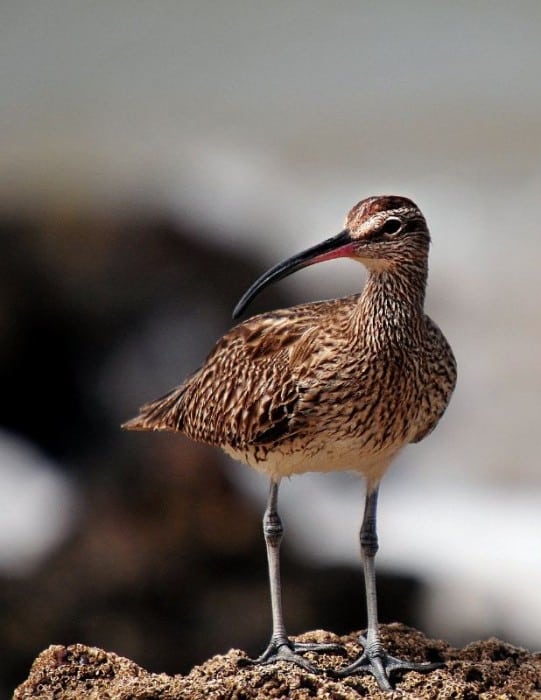
- Scientific name: Numenius phaeopus
- Length: 47 cm
- Wingspan: 90 cm
- Weight: 400 gm
The Eurasian whimbrel is a wandering bird belonging to the Scolopacidae family.
It is one of the most widespread of the curlews, breeding across much of subarctic Asia and Europe as far south as Scotland. Its habitats include along the coast, salt marshes, open tundra, beaches, and mudflats, here, In these habitats they feed on fiddler crabs, marine invertebrates, berries and insects.
24.Trumpeter Swan
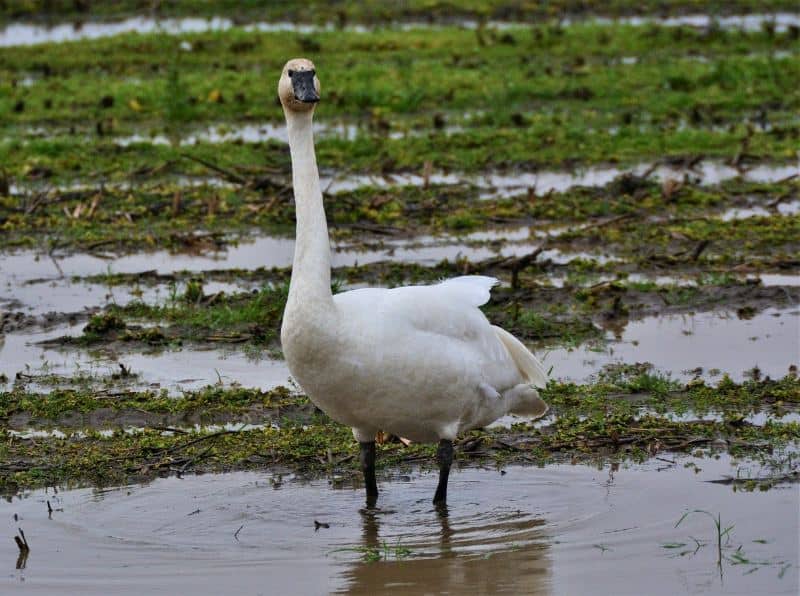
- Scientific name: Cygnus buccinator
- Length: 1.6 m
- Wingspan: 2.5 m
- Weight: 14 Kg
The trumpeter swan is the heaviest living bird found in North America. Its habitats include freshwater, aquatic habitats, farm ponds, lakes, marshes, bogs, freshwater streams, rivers, springs, estuaries and reservoirs.
The foods of trumpeter swans are the tubers, potato, pondweed, stems, leaves, and seeds of aquatic plants.
The trumpeter swan mate for life, when they reach puberty, they select the mate and continue with the same mate until they die, so if any mates die whether they are male or female, then they prefer the new ones.
25.Red-Necked Avocet
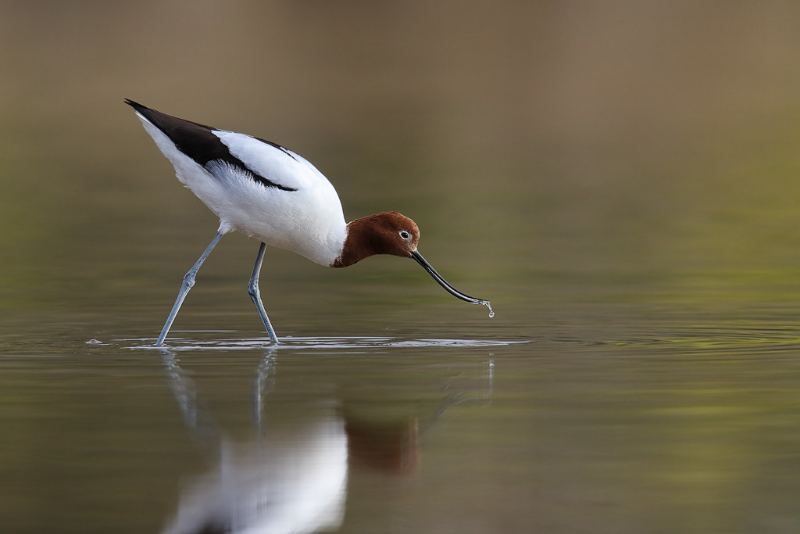
- Scientific name: Recurvirostra novaehollandiae
- Length: 45 cm
- Wingspan: 75 cm
- Weight: 300 gm
The red-necked avocet is a wader bird that belongs to the Recurvirostridae family that is native to Australia.
Whose habitat includes freshwater shallow, saltwater shallow, wetlands and estuarine mudflats. These feed on aquatic insects, aquatic insect larvae, crustaceans, seeds, and other invertebrates. The other names of the Australian avocet are, cobbler, cobbler’s awl, and painted lady.
26.Lesser Flamingo

- Scientific name: Phoeniconaias minor
- Length: 90 cm
- Wingspan: 1 m
- Weight: 2-3 Kg
The lesser flamingo is a type of flamingo that is found in Saharan Africa and northwestern India.
Whose habitats include coastal, inland wetlands, alkaline lakes, saline lakes, salt pans and coastal lagoons. They feed on blue green algae, crustaceans and small insects.
27.Goliath Heron
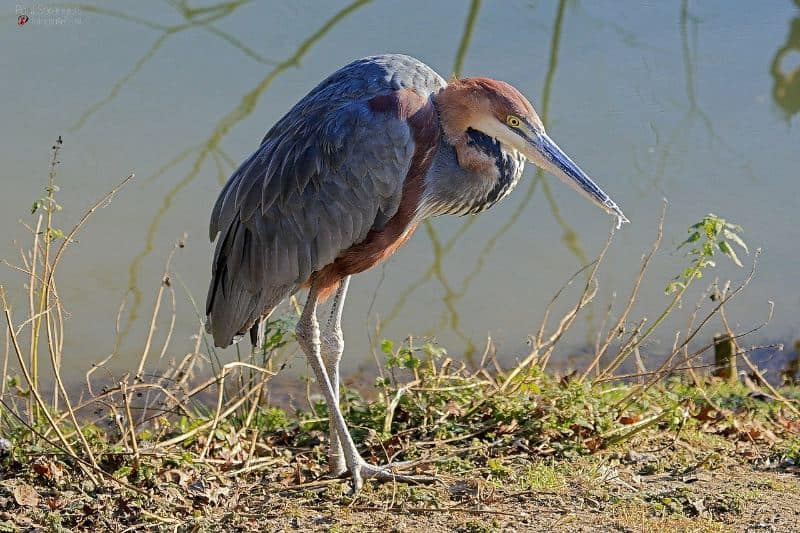
- Scientific name: Ardea goliath
- Length: 1.5 m
- Wingspan: 2.3 m
- Weight: 5 Kg
The Goliath heron or the giant heron, is a very large type of heron which is a wading type in the Ardeidae family, that is found in sub-Saharan Africa and South Asia.
Their habitats include rivers, lakes, estuaries, swamps, marshes, and freshwater shallow. It feeds on large fish, frogs, lizards, snakes, crabs and rodents.
28.Sword-Billed Hummingbird
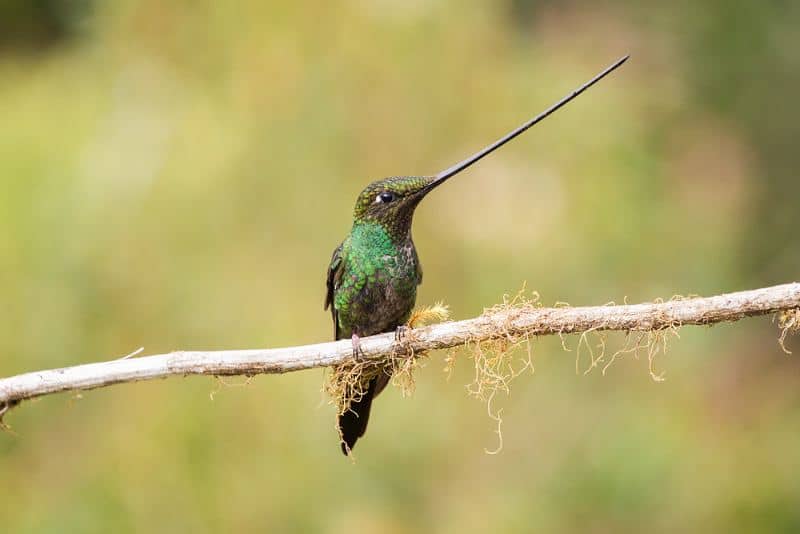
Scientific name: Ensifera ensifera
The sword-billed hummingbird is a bird with very long beak that are belongs to the Trochilidae and are native to South America, also found in Argentina, Bolivia, Colombia, Ecuador, Peru and Venezuela.
Its habitat includes temperate woodlands, mountain meadows, cloud forests, tropical rainforests, deserts, urban and suburban gardens. They feed on the nectar of specific flowers.
